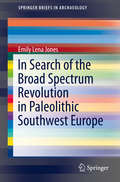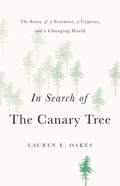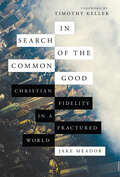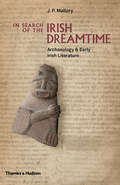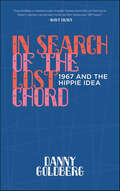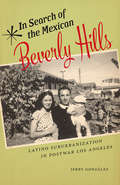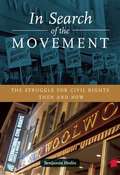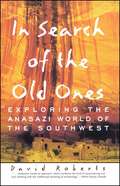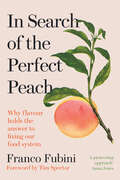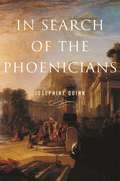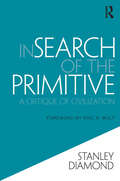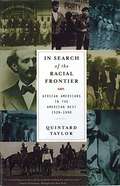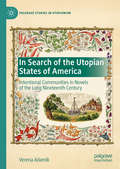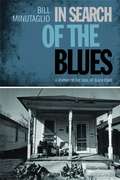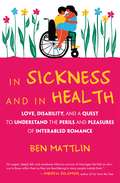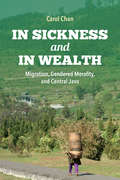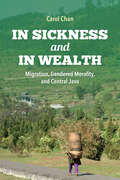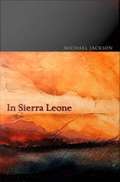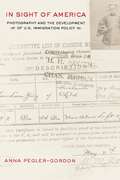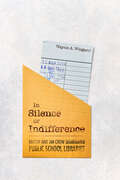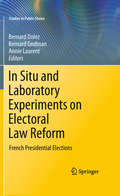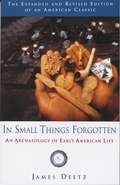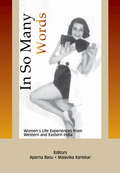- Table View
- List View
In Search of the Broad Spectrum Revolution in Paleolithic Southwest Europe
by Emily Lena JonesThe people who inhabited Southwest Europe from 30,000 to 13,000 years ago are often portrayed as big game hunters - and indeed, in some locations (Cantabrian Spain, the Pyrenees, the Dordogne) the archaeological record supports this interpretation. But in other places, notably Mediterranean Iberia, the inhabitants focused their hunting efforts on smaller game, such as rabbits, fish, and birds. Were they less effective hunters? Were these environments depleted of red deer and other large game? Or is this evidence of Paleolithic people's adaptability? This volume explores these questions, along the way delving into the history of the "bigger equals better" assumption; optimal foraging theory and niche construction theory; and patterns of environmental and subsistence change across the Pleistocene-Holocene transition.
In Search of the Canary Tree: The Story of a Scientist, a Cypress, and a Changing World
by Lauren E. OakesThe surprisingly hopeful story of one woman's search for resiliency in a warming worldSeveral years ago, ecologist Lauren E. Oakes set out from California for Alaska's old-growth forests to hunt for a dying tree: the yellow-cedar. With climate change as the culprit, the death of this species meant loss for many Alaskans. Oakes and her research team wanted to chronicle how plants and people could cope with their rapidly changing world. Amidst the standing dead, she discovered the resiliency of forgotten forests, flourishing again in the wake of destruction, and a diverse community of people who persevered to create new relationships with the emerging environment. Eloquent, insightful, and deeply heartening, In Search of the Canary Tree is a case for hope in a warming world.
In Search of the Common Good: Christian Fidelity in a Fractured World
by Jake MeadorCommon life in our society is in decline. Our communities are disintegrating, as the loss of meaningful work and the breakdown of the family leave us anxious and alone—indeed, half of all Americans report daily feelings of loneliness. Our public discourse is polarized and hateful. Ethnic minorities face systemic injustices and the ever-present fear of violence and deportation. Economic inequalities are widening. In this book, Jake Meador diagnoses our society's decline as the failure of a particular story we've told about ourselves: the story of modern liberalism. He shows us how that story has led to our collective loss of meaning, wonder, and good work, and then recovers each of these by grounding them in a different story—a story rooted in the deep tradition of the Christian faith. Our story doesn't have to end in loneliness and despair. There are reasons for hope—reasons grounded in a different, better story. In Search of the Common Good reclaims a vision of common life for our fractured times: a vision that doesn't depend on the destinies of our economies or our political institutions, but on our citizenship in a heavenly city. Only through that vision—and that citizenship—can we truly work together for the common good.
In Search of the Irish Dreamtime: Archaeology and Early Irish Literature
by J. P. MalloryIreland's oldest traditions excavated via archaeological, genetic, and linguistic research, culminating in atruly groundbreaking publication Following his account of Irish origins drawing on archaeology, genetics, and linguistics, J. P. Mallory returns to the subject to investigate what he calls the Irish Dreamtime: the native Irish retelling of their own origins, as related by medieval manuscripts. He explores the historical backbone of this version of the earliest history of Ireland, which places apparently mythological events on a concrete timeline of invasions, colonization, and royal reigns that extends even further back in time than the history of classical Greece. The juxtaposition of traditional Dreamtime tales and scientific facts expands on what we already know about the way of life in Iron Age Ireland. By comparing the world depicted in the earliest Irish literary tradition with the archaeological evidence available on the ground, Mallory explores Ireland's rich mythological tradition and tests its claims to represent reality.
In Search of the Lost Chord: 1967 and the Hippie Idea
by Danny GoldbergThis paperback edition of Goldberg’s highly acclaimed homage to 1967 includes a new afterword and twenty beautiful and evocative photographs.“Antiwar radicals, recoiling from soullessness, challenged the church of technocratic rationality. Taking this challenge seriously, recovering the mood of an extended moment, requires beginning earlier and ending later than 1968. Cultural upheaval cannot be confined by the calendar. At least one contribution to the literature, the music industry executive Danny Goldberg’s In Search of the Lost Chord, treats 1967 as the defining moment when ‘the hippie idea’ still held transformational promise, and countercultural protest had not yet succumbed to police violence, undercover provocateurs, or media caricature—while 1968, in contrast, was a dark time of assassinations, riots, and the resurgence of the right.” —New York Review of Books“[Goldberg’s] newest book, In Search of the Lost Chord: 1967 and the Hippie Idea, explores and fuses together the musical, political, and spiritual revolutions of the time into a narrative about a moment when ‘there was an instant sense of tribal intimacy one could have even with a stranger.'” —Rolling StoneIn Search of the Lost Chord is a subjective history of 1967, the year Danny Goldberg graduated from high school. It is also a refreshing and new analysis of the era; by looking at not only the political causes, but also the spiritual, musical, and psychedelic movements, Goldberg provides a unique perspective on how and why the legacy of 1967 lives on today. 1967 was the year of the release of the Beatles’ Sgt. Pepper’s Lonely Hearts Club Band, and of debut albums from the Doors, the Grateful Dead, Jimi Hendrix, and Janis Joplin, among many others. 1967 was also the year of the Summer of Love; the year that millions of now-illegal LSD tabs flooded America; Muhammad Ali was convicted of avoiding the draft; Martin Luther King Jr. publicly opposed the war in Vietnam; Stokely Carmichael championed Black Power; Israel won the Six-Day War; and Che Guevara was murdered. It was the year that hundreds of thousands of protesters vainly attempted to levitate the Pentagon. It was the year the word “hippie” peaked and died, and the Yippies were born. Exhaustively researched and informed by interviews and conversations with Allen Ginsberg, Timothy Leary, Ram Dass, Tom Hayden, Cora Weiss, Grace Slick, and others, In Search of the Lost Chord is a mosaic of seminal moments in the psychedelic, spiritual, rock-and-roll, and political protest cultures of 1967. This paperback edition includes a brand-new afterword by the author, along with twenty photographs by Peter Simon.
In Search of the Mexican Beverly Hills: Transnational Cultures in the United States)
by Jerry GonzálezResidential and industrial sprawl changed more than the political landscape of postwar Los Angeles. It expanded the employment and living opportunities for millions of Angelinos into new suburbs. In Search of the Mexican Beverly Hills examines the struggle for inclusion into this exclusive world—a multilayered process by which Mexican Americans moved out of the barrios and emerged as a majority population in the San Gabriel Valley—and the impact that movement had on collective racial and class identity. Contrary to the assimilation processes experienced by most Euro-Americans, Mexican Americans did not graduate to whiteness on the basis of their suburban residence. Rather, In Search of the Mexican Beverly Hills illuminates how Mexican American racial and class identity were both reinforced by and took on added metropolitan and transnational dimensions in the city during the second half of the twentieth century.
In Search of the Movement
by Benjamin Hedin"Benjamin Hedin went looking for the civil rights movement's past, but he also ran smack into the present, which can suddenly look like the past and then just as suddenly look totally different. By bringing stirring people like Septima Clark into focus, Hedin does what good historians do, but by entwining history with current events, he does a lot more. Here is a haunting meditation on living in history as well as with it."--Sean Wilentz, author of The Rise of American Democracy: Jefferson to LincolnIn March of 1965, Martin Luther King led thousands in an epic march from Selma, Alabama to the state capital in Montgomery, in what is often seen as the culminating moment of the Civil Rights movement. The Voting Rights Act was signed into law that year, and with Jim Crow eradicated, and schools being desegregated, the movement had supposedly come to an end. America would go on to record its story as an historic success.Recently, however, the New York Times featured an article that described the reversion of Little Rock's schools to all-black or all-white. The next day, the paper printed a story about a small town in Alabama where African Americans were being denied access to the polls. Massive demonstrations in cities across the country protest the killing of black men by police, while we celebrate a series of 50th-anniversary commemorations of the signature events of the Civil Rights movement. In such a time it is important to ask: In the last fifty years, has America progressed on matters of race, or are we stalled--or even moving backward?With these questions in mind, Benjamin Hedin set out to look for the Civil Rights movement. "I wanted to find the movement in its contemporary guise," he writes, "which also meant answering the critical question of what happened to it after the 1960s." He profiles legendary figures like John Lewis, Robert Moses, and Julian Bond, and also visits with contemporary leaders such as William Barber II and the staff of the Dream Defenders. But just as powerful--and instructional--are the stories of those whose work goes unrecorded, the organizers and teachers who make all the rest possible.In these pages the movement is portrayed as never before, as a vibrant tradition of activism that remains in our midst. In Search of the Movement is a fascinating meditation on the patterns of history, as well as an indelible look at the meaning and limits of American freedom.Benjamin Hedin has written for the New Yorker, Slate, the Nation, and the Chicago Tribune. He's the editor of Studio A: The Bob Dylan Reader, and the producer and author of a forthcoming documentary film, The Blues House.
In Search of the New Woman: Middle-Class Women and Work in Britain 1870-1914
by Gillian SutherlandThe 'New Women' of late nineteenth-century Britain were seen as defying society's conventions. Studying this phenomenon from its origins in the 1870s to the outbreak of the Great War, Gillian Sutherland examines whether women really had the economic freedom to challenge norms relating to work, political action, love and marriage, and surveys literary and pictorial representations of the New Woman. She considers the proportion of middle-class women who were in employment and the work they did, and compares the different experiences of women who went to Oxbridge and those who went to other universities. Juxtaposing them against the period's rapidly expanding but seldom studied groups of women white-collar workers, the book pays particular attention to clerks and teachers and their political engagement. It also explores the dividing lines between ladies and women, the significance of respectability and the interactions of class, status and gender lying behind such distinctions.
In Search of the Old Ones: Exploring the Anasazi World of the Southwest
by David RobertsThe Anasazi, ancestors of the Pueblo people, inhabited the Southwest for at least 5,000 years. David Roberts' extensive interviews and back country travels create a richly detailed portrait of an enigmatic people.
In Search of the Perfect Peach: Why flavour holds the answer to fixing our food system
by Franco FubiniWITH A FOREWORD FROM TIM SPECTOR, author of The Diet Myth, Spoon-Fed and Food for Life ‘This book is a passionate rallying call for a change of mindset…’ Mail on Sunday "A pioneering approach."—Anna Jones, cook and bestselling author of Easy Wins "By valuing and reclaiming flavour, Franco argues that we can transform the system and also enrich our relationship with food. Essential reading."—Dan Saladino, journalist, broadcaster and author of Eating to Extinction Let flavour guide our food choices – and lead us to a better food future. In Search of the Perfect Peach shows us how this simple desire can bring about a healthier, tastier and brighter future for our food, the people who produce it and the soil it grows in. That first bite of a perfectly ripe peach can be truly transformative – a joyful moment that will stay with you forever. For Franco Fubini, founder and CEO of Natoora, this encounter also leads him to realise that flavour is not simply a fleeting, visceral experience but a window into the farmer, a connection to our natural environment and a taste test for our food system. What makes a great-tasting tomato? Why is scarring on a greengage a good sign? Does ‘eating local’ narrow our priorities to the exclusion of others? In Search of the Perfect Peach follows Franco as he navigates the food system in pursuit of this elusive element. As he takes us from Sicily’s citrus groves to the streets of Mexico City, he shows how we have allowed the wider industry to compromise on more than just flavour. Franco’s search for the Greta peach culminates in his own clarity and conviction: by looking to flavour, we can unpick the industrialisation of our food production, restore nutrition and seasonal diversity to our plates and the craft of growing back to our landscapes. And, above all, we can find that perfect peach every summer. "This exciting and important book now brings Natoora and all its ingredients not just to restaurants like ours but … to everyone’s home."—Ruth Rogers, chef and co-founder of The River Cafe "An incredible read for those who love food and care about its future. In Search of the Perfect Peach is both a love story and technical guide."—Kyle Connaughton, chef and owner of SingleThread Farm, Restaurant and Inn
In Search of the Phoenicians (Miriam S. Balmuth Lectures in Ancient History and Archaeology)
by Josephine QuinnWho were the ancient Phoenicians, and did they actually exist?The Phoenicians traveled the Mediterranean long before the Greeks and Romans, trading, establishing settlements, and refining the art of navigation. But who these legendary sailors really were has long remained a mystery. In Search of the Phoenicians makes the startling claim that the “Phoenicians” never actually existed. Taking readers from the ancient world to today, this monumental book argues that the notion of these sailors as a coherent people with a shared identity, history, and culture is a product of modern nationalist ideologies—and a notion very much at odds with the ancient sources.Josephine Quinn shows how the belief in this historical mirage has blinded us to the compelling identities and communities these people really constructed for themselves in the ancient Mediterranean, based not on ethnicity or nationhood but on cities, family, colonial ties, and religious practices. She traces how the idea of “being Phoenician” first emerged in support of the imperial ambitions of Carthage and then Rome, and only crystallized as a component of modern national identities in contexts as far-flung as Ireland and Lebanon.In Search of the Phoenicians delves into the ancient literary, epigraphic, numismatic, and artistic evidence for the construction of identities by and for the Phoenicians, ranging from the Levant to the Atlantic, and from the Bronze Age to late antiquity and beyond. A momentous scholarly achievement, this book also explores the prose, poetry, plays, painting, and polemic that have enshrined these fabled seafarers in nationalist histories from sixteenth-century England to twenty-first century Tunisia.
In Search of the Primitive: A Critique of Civilization (Routledge Classic Texts in Anthropology)
by Stanley DiamondAnthropology is a kind of debate between human possibilities—a dialectical movement between the anthropologist as a modern man and the primitive peoples he studies. In Search of the Primitive is a tough-minded book containing chapters ranging from encounters in the field to essays on the nature of law, schizophrenia and civilization, and the evolution of the work of Claude Lévi-Strauss. Above all it is reflective and self-critical, critical of the discipline of anthropology and of the civilization that produced that discipline. Diamond views the anthropologist who refuses to become a searching critic of his own civilizations as not merely irresponsible, but a tool of Western civilization. He rejects the associations which have been made in the ideology of our civilization, consciously or unconsciously, between Western dominance and progress, imperialism and evolution, evolution and progress.
In Search of the Racial Frontier: African Americans in the American West 1528-1990
by Quintard Taylor"This is an enthralling work that will be essential reading for years to come. You finish it understanding how integral a part blacks were of the making of the West and, indeed, America." -- David Nicholson, Washington Post A landmark history of African Americans in the West, In Search of the Racial Frontier rescues the collective American consciousness from thinking solely of European pioneers when considering the exploration, settling, and conquest of the territory west of the Mississippi. From its surprising discussions of groups of African American wholly absorbed into Native American culture to illustrating how the largely forgotten role of blacks in the West helped contribute to everything from the Brown vs. Board of Education desegregation ruling to the rise of the Black Panther Party, Quintard Taylor fills a major void in American history and reminds us that the African American experience is unlimited by reion or social status. "[Rich] in scope and scholarly detail -- it will certinaly stand as the definitive work on the subject for some time to come." -- James A. Miller, Boston Globe "[B]y far the most complete general history of blacks in the West." -- Scott L. Malcolmson, Newsday "An absorbing chronicle." -- Publisher's Weekly "Those looking for a solid overview of the African-American presence in our region would do well to let Quintard Taylor be their guide." -- John C. Walter, Seattle Times
In Search of the Utopian States of America: Intentional Communities in Novels of the Long Nineteenth Century (Palgrave Studies in Utopianism)
by Verena AdamikThis book endeavours to understand the seemingly direct link between utopianism and the USA, discussing novels that have never been brought together in this combination before, even though they all revolve around intentional communities: Imlay’s The Emigrants (1793), Hawthorne’s The Blithedale Romance (1852), Howland’s Papas Own Girl (1874), Griggs’s Imperium in Imperio (1899), and Du Bois’s The Quest of the Silver Fleece (1911). They relate nation and utopia not by describing perfect societies, but by writing about attempts to immediately live radically different lives. Signposting the respective communal history, the readings provide a literary perspective to communal studies, and add to a deeply necessary historicization for strictly literary approaches to US utopianism, and for studies that focus on Pilgrims/Puritans/Founding Fathers as utopian practitioners. This book therefore highlights how the authors evaluated the USA’s utopian potential and traces the nineteenth-century development of the utopian imagination from various perspectives.
In Search of the blues
by Bill MinutaglioThe rich, complex lives of African Americans in Texas were often neglected by the mainstream media, which historically seldom ventured into Houston’s Fourth Ward, San Antonio’s East Side, South Dallas, or the black neighborhoods in smaller cities. When Bill Minutaglio began writing for Texas newspapers in the 1970s, few large publications had more than a token number of African American journalists, and they barely acknowledged the things of lasting importance to the African American community. Though hardly the most likely reporter—as a white, Italian American transplant from New York City—for the black Texas beat, Minutaglio was drawn to the African American heritage, seeking its soul in churches, on front porches, at juke joints, and anywhere else that people would allow him into their lives. His nationally award-winning writing offered many Americans their first deeper understanding of Texas’s singular, complicated African American history. This eclectic collection gathers the best of Minutaglio’s writing about the soul of black Texas. He profiles individuals both unknown and famous, including blues legends Lightnin’ Hopkins, Amos Milburn, Robert Shaw, and Dr. Hepcat. He looks at neglected, even intentionally hidden, communities. And he wades into the musical undercurrent that touches on African Americans’ joys, longings, and frustrations, and the passing of generations. Minutaglio’s stories offer an understanding of the sweeping evolution of music, race, and justice in Texas. Moved forward by the musical heartbeat of the blues and defined by the long shadow of racism, the stories measure how far Texas has come . . . or still has to go.
In Sickness and in Health: Love, Disability, and a Quest to Understand the Perils and Pleasures ofInterabled Romance
by Ben MattlinA frank, humorous exploration of interabled dating, love, and marriageBen Mattlin’s wife, ML, recalls falling in love with his confidence and sheer determination. On one of their earliest dates, he persuaded her to ride on his lap in his wheelchair on their way home from an Elvis Costello concert. Thirty years later, they still travel like this from time to time, undaunted by the curious stares following them down the street.But In Sickness and in Health is more than an “inspiring” story of how a man born with spinal muscular atrophy—a congenital and incurable neuromuscular condition—survived childhood, graduated from Harvard, married an able-bodied woman, built a family with two daughters and a cat and a turtle, established a successful career in journalism, and lived happily ever after. As Mattlin considers the many times his relationship has been met with surprise or speculation by outsiders—those who consider his wife a “saint” or him just plain “lucky” for finding love—he issues a challenge to readers: why should the idea of an “interabled” couple be regarded as either tragic or noble?Through conversations with more than a dozen other couples of varying abilities, ethnic backgrounds, and orientations, Mattlin sets out to understand whether these pairings are as unusual as onlookers seem to think. Reflecting on his own experience he wonders: How do people balance the stresses of personal-care help with the thrill of romance? Is it possible that the very things that appear to be insurmountable obstacles to a successful relationship—the financial burdens, the physical differences, the added element of an especially uncertain future—could be the building blocks of an enviable level of intimacy and communication that other couples could only dream of?We meet Shane Burcaw, a twenty-three-year-old writer, who offers a glimpse of his first forays into dating with a disability. There’s Rachelle Friedman, the “paralyzed bride,” as the media refers to her, and her husband, discussing the joys and challenges of a new marriage and a growing family. And Christina Crosby and her partner, Janet Jakobsen, reflect on how Crosby’s disabling accident called for them to renegotiate their roles and expectations in their long-term relationship. What emerges is a candid glimpse into the challenges and joys of interabled love—from the first blush of sexual awakening to commitment and marriage and through to widowhood.
In Sickness and in Wealth: Migration, Gendered Morality, and Central Java (Framing the Global)
by Carol ChanVillagers in Indonesia hear a steady stream of stories about the injuries, abuses, and even deaths suffered by those who migrate in search of work. So why do hundreds of thousands of Indonesian workers continue to migrate every year? Carol Chan explores this question from the perspective of the origin community and provides a fascinating look at how gender, faith, and shame shape these decisions to migrate. Villagers evaluate men's and women’s migrations differently, leading to different ideas about which kinds of human or financial flows should be encouraged and which should be discouraged or even criminalized. Despite routine and well-documented instances of exploitation of Indonesian migrant workers, some villagers still emphasize that a migrant's success or failure ultimately depends on that individual’s morality, fate, and destiny. Indonesian villagers construct strategies for avoiding migration-related risks that are closely linked to faith and belief in supernatural agency. These strategies shape the flow of migration from the country and help to ensure the continued confidence Indonesian people have in migration as an act of promise and hope.
In Sickness and in Wealth: Migration, Gendered Morality, and Central Java (Framing the Global)
by Carol ChanAn expert in migration studies examines the cultural context of villages in Central Java and their influence on those who pursue migrant labor.Villagers in Indonesia hear a steady stream of stories about the injuries, abuses, and even deaths suffered by those who migrate in search of work. So why do hundreds of thousands of Indonesian workers continue to migrate every year? Carol Chan explores this question from the perspective of the origin community and provides a fascinating look at how gender, faith, and shame shape these decisions to migrate.Chan reveals how villagers evaluate men’s and women’s migrations differently. This disparity leads to different ideas about which kinds of human or financial flows should be encouraged and which should be discouraged or even criminalized. Despite routine and well-documented instances of exploitation of Indonesian migrant workers, some villagers still emphasize that a migrant’s success or failure ultimately depends on that individual’s morality, fate, and destiny.Indonesian villagers construct strategies for avoiding migration-related risks that are closely linked to faith and belief in supernatural agency. These strategies shape the flow of migration from the country and help to ensure the continued confidence Indonesian people have in migration as an act of promise and hope.
In Sierra Leone
by Michael JacksonIn 2002, as Sierra Leone prepared to announce the end of its brutal civil war, the distinguished anthropologist, poet, and novelist Michael Jackson returned to the country where he had intermittently lived and worked as an ethnographer since 1969. While his initial concern was to help his old friend Sewa Bockarie (S. B. ) Marah--a prominent figure in Sierra Leonean politics--write his autobiography, Jackson's experiences during his stay led him to create a more complex work: In Sierra Leone, a beautifully rendered mosaic integrating S. B. 's moving stories with personal reflections, ethnographic digressions, and meditations on history and violence. Though the Revolutionary United Front (R. U. F. ) ostensibly fought its war (1991-2002) against corrupt government, the people of Sierra Leone were its victims. By the time the war was over, more than fifty thousand were dead, thousands more had been maimed, and over one million were displaced. Jackson relates the stories of political leaders and ordinary people trying to salvage their lives and livelihoods in the aftermath of cataclysmic violence. Combining these with his own knowledge of African folklore, history, and politics and with S. B. 's bittersweet memories--of his family's rich heritage, his imprisonment as a political detainee, and his position in several of Sierra Leone's post-independence governments--Jackson has created a work of elegiac, literary, and philosophical power.
In Sight of America: Photography and the Development of U. S. Immigration Policy
by Anna Pegler-GordonThis work is the first to take a comprehensive look at the history of immigration policy in the United States through the prism of visual culture. Anna Pegler-Gordon considers the role and uses of visual documentation at Angel Island for Chinese immigrants, at Ellis Island for European immigrants, and on the U.S.-Mexico border.
In Sight of America: Photography and the Development of U.S. Immigration Policy (American Crossroads #28)
by Dr. Anna Pegler-GordonWhen restrictive immigration laws were introduced in the late-nineteenth and early-twentieth centuries, they involved new requirements for photographing and documenting immigrants--regulations for visually inspecting race and health. This work is the first to take a comprehensive look at the history of immigration policy in the United States through the prism of visual culture. Including many previously unpublished images, and taking a new look at Lewis Hine's photographs, Anna Pegler-Gordon considers the role and uses of visual documentation at Angel Island for Chinese immigrants, at Ellis Island for European immigrants, and on the U.S.-Mexico border. Including fascinating close visual analysis and detailed histories of immigrants in addition to the perspectives of officials, this richly illustrated book traces how visual regulations became central in the early development of U.S. immigration policy and in the introduction of racial immigration restrictions. In so doing, it provides the historical context for understanding more recent developments in immigration policy and, at the same time, sheds new light on the cultural history of American photography.
In Silence or Indifference: Racism and Jim Crow Segregated Public School Libraries
by Wayne A. WiegandLibrarians around the country are currently on a battleground, defending their right to purchase and circulate books dealing with issues of race and systemic racism. Despite this work, the library community has often overlooked—even ignored—its own history of White supremacy and deliberate inaction on the part of White librarians and library leadership. Author Wayne A. Wiegand takes a crucial step to amend this historical record. In Silence or Indifference: Racism and Jim Crow Segregated Public School Libraries analyzes and critiques the world of professional librarianship between 1954 and 1974.Wiegand begins by identifying racism in the practice and customs of public school libraries in the years leading up to the Brown v. Board of Education decision. This culture permeated the next two decades, as subsequent Supreme Court decisions led to feeble and mostly unsuccessful attempts to integrate Jim Crow public schools and their libraries. During this same period, the profession was honing its national image as a defender of intellectual freedom, a proponent of the freedom to read, and an opponent of censorship. Still, the community did not take any unified action to support Brown or to visibly oppose racial segregation. As Black school librarians and their Black patrons suffered through the humiliations and hostility of the Jim Crow educational establishment, the American library community remained largely ambivalent and silent.The book brings to light a distressing history that continues to impact the library community, its students, and its patrons. Currently available school library literature skews the historical perspective that informs the present. In Silence or Indifference is the first attempt to establish historical accountability for the systemic racism contemporary school librarianship inherited in the twenty-first century.
In Situ and Laboratory Experiments on Electoral Law Reform
by Bernard Grofman Annie Laurent Bernard DolezIn the modern era, representation is the hallmark of democracy, and electoral rules structure how representation works and how effectively governments perform. Moreover, of the key structural variables in constitutional design, it is the choice of electoral system that is usually the most open to change. There are three distinctive approaches to electoral system research. One, associated largely with economics, involves the study of electoral system effects through the deductive method, using mathematical tools to derive theorems about the properties of voting methods and behaviors. A second, associated largely with political science, has a primarily empirical focus, and looks in depth at how electoral rules impact on political outcomes, through large cross-sectional or case studies. A third, and more recent tradition, inspired largely by work in experimental economics, involves experimentation, either in the form of controlled laboratory experiments or in the form of in situ field studies. This volume employs the third approach to report on experiments that look at alternatives to the present two round (majority runoff) system used for the election of French presidents. This system is of considerable importance not just because of its use in France but also because of its wide adoption in presidential elections in new democracies, such as Bulgaria, Poland, Romania, Russia and Ukraine. The editors have assembled the top experimental economists and political scientists specializing in French politics to provide in-depth analysis of the double ballot electoral system, and, more broadly, of the effect of electoral rules on the number of candidates, voter strategies, and ideological choice. Ultimately, the editors and contributors argue that experimental methods have great potential to inform our understanding of institutional mechanisms in the context of voting behavior.
In Small Things Forgotten: An Archaeology of Early American Life
by James DeetzHistory is recorded in many ways. According to author James Deetz, the past can be seen most fully by studying the small things so often forgotten. Objects such as doorways, gravestones, musical instruments, and even shards of pottery fill in the cracks between large historical events and depict the intricacies of daily life. In his completely revised and expanded edition ofIn Small Things Forgotten, Deetz has added new sections that more fully acknowledge the presence of women and African Americans in Colonial America. New interpretations of archaeological finds detail how minorities influenced and were affected by the development of the Anglo-American tradition in the years following the settlers' arrival in Plymouth, Massachusetts in 1620. Among Deetz's observations: Subtle changes in building long before the Revolutionary War hinted at the growing independence of the American colonies and their desire to be less like the British. Records of estate auctions show that many households in Colonial America contained only one chair--underscoring the patriarchal nature of the early American family. All other members of the household sat on stools or the floor. The excavation of a tiny community of freed slaves in Massachusetts reveals evidence of the transplantation of African culture to North America. Simultaneously a study of American life and an explanation of how American life is studied,In Small Things Forgotten, through the everyday details of ordinary living, colorfully depicts a world hundreds of years in the past.
In So Many Words: Women’s Life Experiences from Western and Eastern India
by Aparna BasuThis volume will mark a new trend in dealing with women’s varied experiences of life: individual introductions situate the narrator in a context – and then her voice takes over, with no intervention from the editors (except to provide footnotes wherever necessary).The personal narrative — be it an autobiography, a letter or a diary — has come to be recognised as an acceptable data source in history and social science. Literary critics and students of literature too find considerable use in reading the personal writings of poets, fiction and crime writers. In this book, readings of personal narratives help in painting various images of lives that we can only know at second hand. The mélange includes memoirs, published articles, ‘portraits from memory’, a collection of essays , and an oral interview. In all, the self was the focus. The writings of Sailabala, Li Gotami, and Shakuntala go beyond a recounting of their lives and deal with spiritual and travel experiences. Three of the essays are excerpts from published autobiographies — Sarala Devi Chaudhurani’s Jeevaner Jharapata (Life’s Fallen Leaves), Kalpana Dutt’s Reminiscences and Sailabala Das’s A Look Before and After. Vidyagauri Nilkanth’s writings are essays and a selection of amazingly candid letters exchanged with her husband. Anasuya Sarabahi’s is an interview in Gujarati with niece Gira and Monica’s a selection from an unpublished memoir. Li Gotami, whose original name was Rutty Petit, travelled to Manasarovar, and a few of the magazine articles on this amazing journey have been reproduced here. Whichever form a woman chooses, writing about her self, is emancipatory; she may be a person who has so far received little attention from the family or the world. Or she may be one who is a well-known public figure – yet little is known about her childhood. So she writes about many selves – life is not about one coherent self but rather one of many lives and experiences. In other words,
